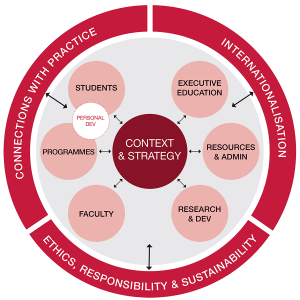By David Asch
Senior Advisor EQUIS
EFMD
LinkedIn
Background
EQUIS was designed as an international accreditation system. It takes into account the diversity of national cultures and educational systems around the world. Therefore, it is essential to begin any assessment with an understanding of the local context. The scope of EQUIS accreditation is institutional, the institution being defined as the organisational unit providing business and management education. This may be a free-standing business school or a unit as part of a wider institution, usually a university of which it is a faculty, school or department, depending on the organisation of the parent institution. The unit may also be part of a foundation. In all cases, it must demonstrate that it has reasonable autonomy in setting its strategic agenda and in managing its budget and that it has its own dedicated faculty and administrative staff.
The wheel diagram below sets out the 10 dimensions of EQUIS. Connections with Practice, Ethics Responsibility and Sustainability, and Internationalisation are transversal dimensions, that is, they relate to the School as a whole. EQUIS welcomes the different profiles of Schools providing they are consistent and coherent.
 Context and Strategy serves to describe the school and its position in the regulatory and competitive environment in which it operates. The school’s overall strategic agenda is also assessed.
Context and Strategy serves to describe the school and its position in the regulatory and competitive environment in which it operates. The school’s overall strategic agenda is also assessed.- Internationalisation
The school should have a clearly articulated strategy and policies for internationalisation, encompassing its student body, faculty, international partnerships, research activity and corporate connections. - Ethics, Responsibility and Sustainability
The school should have a clear understanding of its role as a “globally responsible organisation” and its contribution to ethics and sustainability. This understanding should be reflected in the school’s mission, strategy and activities. - Connections with Practice.
Business schools need to be closely connected to the world of practice, widely defined as commercial, policy and public organisations, which represent the end users of their output of graduates and of knowledge created by the school. - Research and Development
The school’s output from its Research & Development activities should make an impact on the constituencies that are important to and part of the school’s strategy, such as academic research, applied research as well as pedagogical research and innovation that may affect the learning and teaching strategy. - The Programmes should be well designed with clear learning outcomes and an appropriate balance between knowledge acquisition and skills acquisition.
- The Faculty should be well-qualified and should be active in both research and learning and teaching. Sufficient core faculty is needed to cover the major disciplines and constitute a viable body of distinctive expertise (i.e. a minimum of 25 FTE).
- The school should ensure the quality of its students through appropriate selection processes, through the management of student progression in its programmes, and through the provision of appropriate student services. The school should actively help students to define their future professional orientation.
- You must be familiar with the EQUIS STANDARDS AND CRITERIA, the EQUIS PROCESS MANUAL and the PROCESS MANUAL ANNEXES. These Manuals are available at https://www.efmdglobal.org/accreditations/business-schools/equis/equis-guides-documents/
- Members of the EQUIS team are available to discuss any issues that a School may have. We normally arrange meetings with colleagues from Schools to coincide with EFMD events such as the Deans and Directors Conference (that usually takes place in late February).
There is also a series of seminars for colleagues new to the EQUIS process, details of which are on the website.
Please do not hesitate to get in touch equis@efmdglobal.org

0 Comments